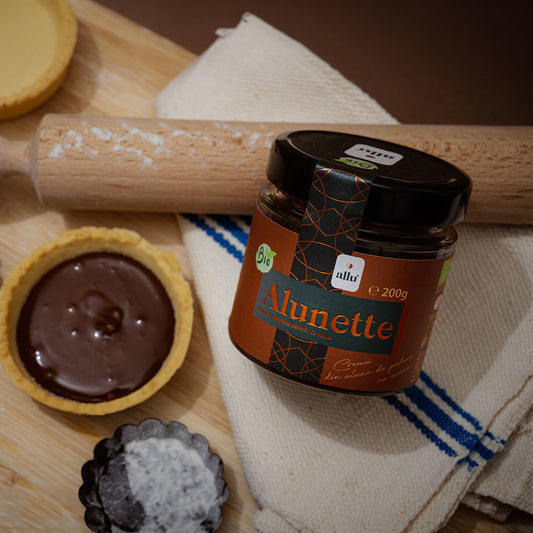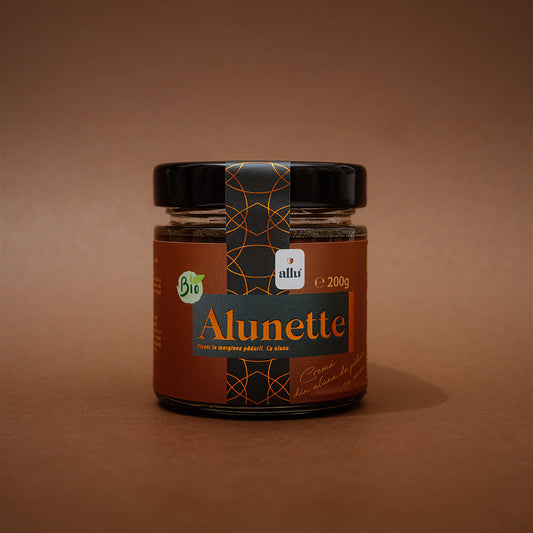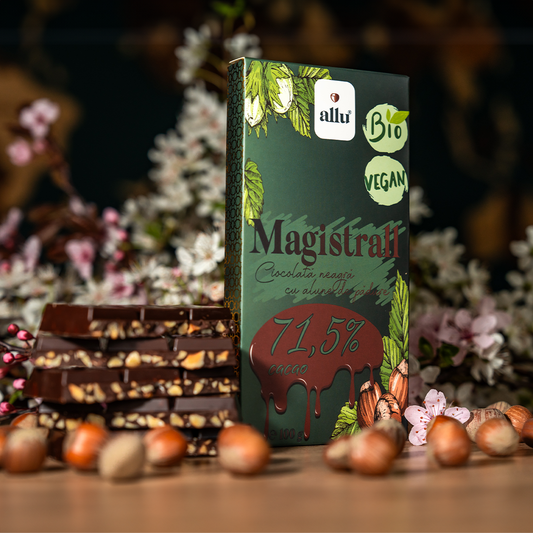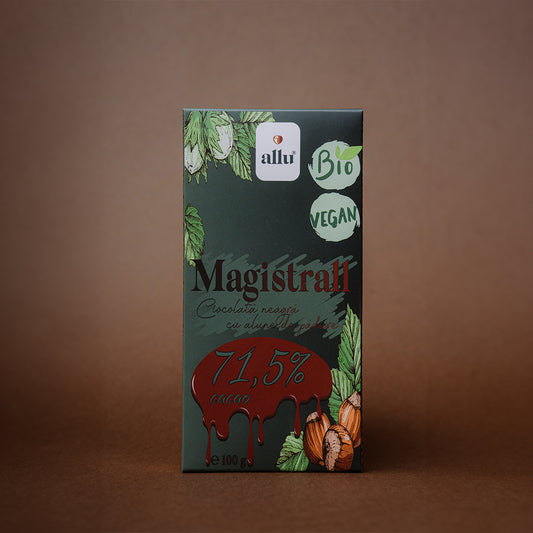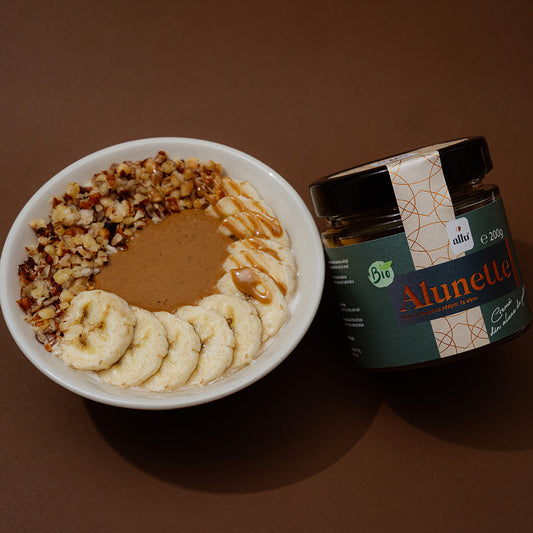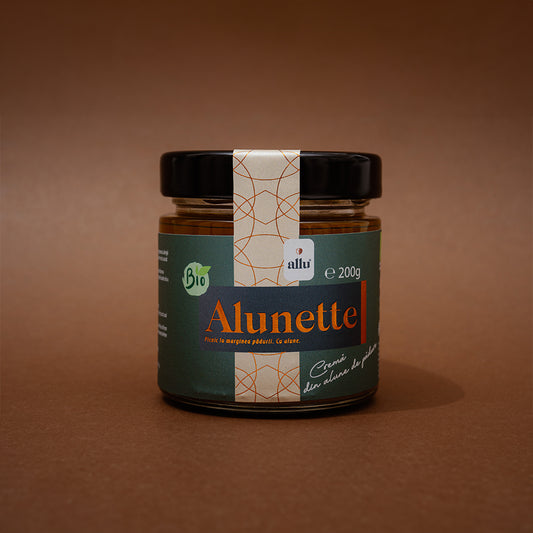ALUNETTE WITH COCOA: A Healthy and Nutritious Delight
Today we present you a special product, a Romanian delicacy, created from the desire to offer a high-quality food, from carefully selected and certified organic ingredients. This product, Alunette – hazelnut cream with cocoa , is a true symphony of flavors designed to meet the requirements of even the most demanding customers, being a healthy alternative to similar products on the market. The motivation behind The reason for the creation of this product, Alunette – hazelnut cream with cocoa, was the worrying awareness regarding the very low percentage of hazelnuts found in Romanian spreads. Now there is already a hazelnut-based spread with a high percentage of hazelnuts, which not only satisfies gourmet pleasures, but also contributes to the proper functioning of the body.
The main ingredient, 80% of the total finished product, is carefully roasted and selected hazelnuts. Roasting is an essential technological process, because the sugars and amino acids naturally found in its composition go through several caramelization processes and Maillard reactions, producing a complex series of chemical compounds that form the intense and pleasant aroma of hazelnuts [1]. The major advantage of hazelnuts is their unsaturated fatty acids, especially oleic acid, also known as Omega-9, which our human body cannot synthesize. This is known for its properties of contributing to maintaining normal blood cholesterol levels [2]. Several specialized studies [3] have demonstrated that the roasting process does not significantly affect the content of healthy lipids in hazelnuts, so even in roasted and spreadable form we can find a high content of oleic acid in the proportion of 77.9 - 82.2% of total unsaturated fatty acids.
Our cream couldn't be complete without a touch of sweetness in it, so, with the health of our consumers in mind, we chose to use a natural substitute for white sugar that is less well-known in Romania, namely agave powder. This is extracted from a plant specific to Mexico, Agave tequilana, (yes, the alcoholic beverage tequila is also made from it), which is made up of approx. 80% fructose and approx. 13% dextrose, thus having a low glycemic index, with a value between 13-27 [4], compared to white sugar, which has a glycemic index of with a value of 65-68. Thus, this agave powder does not represent a negative factor in terms of blood sugar concentration.
Over time, we have received many questions regarding the consumption of Alunette – hazelnut cream with cocoa by diabetics, but our advice is to consult a doctor or nutritionist before introducing this type of product into their diet or to consume in small quantities and in moderation as part of a balanced diet and monitoring the individual glycemic response. Although many fear the adverse effects of fructose on the liver, we can guarantee that per 100 grams of finished product we will not exceed values greater than 10 grams of fructose, and studies [5] show that only a daily consumption of over 50 grams of fructose can negatively affect the liver.
Cocoa powder from organic sources in a percentage of 8% is the ingredient that forms the dark color of the product, as well as the chocolates in the "Magistrall" range, made after processing high-quality cocoa beans which, through fermentation, roasting and alkalization, bring the right flavor that combines perfectly with hazelnuts and forms our soft spreadable cream. The benefits of cocoa beans have been recognized for hundreds of years, such as theobromine and polyphenols that can stimulate the nervous system and reduce mental fatigue by increasing concentration [6].
Sunflower lecithin is a phospholipid with positive effects on maintaining brain health and protecting it in the long term, contributing to the balance of neurotransmitters and supporting memory and learning [7], representing another compound in Alunette – hazelnut cream with cocoa.
All these complex ingredients masterfully create Alunette – hazelnut cream with cocoa, a product with great potential for maintaining brain health and protecting it in the long term.
You may be wondering how all these ingredients manage to form such a fine cream? The secret lies in our ball mill, a high-performance machine made in Italy. It uses a high-speed rotating shaft that drives stainless steel balls in a drum. Through continuous collisions and intense friction forces, the ingredient particles are gradually ground until they reach sizes of 20-30 microns. At this granulation, the human tongue can no longer perceive solid particles, giving the product a perfectly fine texture, with a creamy texture, without the feeling of graininess, essential for a high-quality product. When the particle size reaches the threshold of 20-30 microns, the process is considered complete and the resulting cream is transferred to the next stage of production.
Alunette – hazelnut spread with cocoa is an excellent choice for those who want a premium spread that is both tasty and nutritious. Its innovative formula, based on 80% roasted hazelnuts, sweetened with low-glycemic agave powder and enriched with high-quality cocoa powder, offers not only a refined taste experience, but also significant health benefits. Thus, Alunette is not only a gourmet delicacy, but also a functional food, designed to support both the pleasure of enjoying an exceptional product and the nutritional balance of consumers.
Bibliography:
- Göncüoğlu Taş, N., Gökmen, V., 2016, Maillard Reaction and Caramelization during Hazelnut Roasting: A multiresponse kinetic study, Food Chemistry (2016), doi: http://dx.doi.org/10.1016/j.foodchem.
- Emilio Ros, J. Mataix, 2006, Fatty acid composition of nuts – implications for cardiovascular health, British Journal of Nutrition (2006), 96, Suppl. 2, S29–S35, doi: 10.1017/BJN20061861.
- Joana S. Amaral, Susana Casal, Rosa M. Seabra, Beatriz PP Oliveira, 2006, Effects of Roasting on Hazelnut Lipids, J. Agric. Food Chem 54, pp. 1315-1321, doi: 10.1021/jf052287v.
- Hugo Espinosa-Andrews, Judith Esmeralda Urías-Silvas, N., M.-Hernandez, 2021, The role of agave fructans in health and food applications: A review, Trends in Food Science & Technology 114, pg.585–598, doi: https://doi.org/10.1016/j.tifs.2021.06.022.
- Luc Tappya, Kim-Anne Lêc, 2012, Does fructose consumption contribute to non-alcoholic fatty liver disease?, Clinics and Research in Hepatology and Gastroenterology 36, pp. 554—560, doi: 10.1016/j.clinre.2012.06.005.
- Alexander N. Sokolova, Marina A. Pavlovab, Sibylle Klosterhalfena, P. Encka, 2013, Chocolate and the brain: Neurobiological impact of cocoa flavanols on cognition and behavior, Neuroscience & Biobehavioral Reviews 37, pp. 2445-2453, doi: https://doi.org/10.1016/j.neubiorev.2013.06.013
- Shahrzad Latifi et al., 2016, Natural lecithin promotes neural network complexity and activity, Scientific Reports. 6. 25777, doi: 10.1038/srep25777.
Author: Eng. Kiss David















